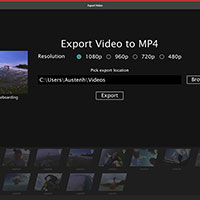


Additionally, 4K is limited to the “wide” field of view and doesn’t allow for lens distortion correction to be enabled. The three-axis electronic image stabilization, for example, simply doesn’t work in 4K or 2.7K mode. We found an exposure compensation of -1EV was just about right, but this could be different depending on the situation.)Īs good as the 4K is, however, many features are limited to 1080p.

On a bright day, however, this will blow out the highlights. (Flat profiles often produce more noise, so overexposure could be intentional to limit the noise by letting more light into the shadows.
#GARMIN VIRB EDIT STOPPED WORKING ISO#
Exposure compensation and ISO limit can also be set, which was particularly important as we found the Ultra 30 tended to overexpose images, at least when using the flat color profile. We were pleased to see that Garmin included a swath of advanced settings, as well, including three different levels of sharpness, a high bitrate mode that records at 60 megabits per second, and the option for a flat color profile that maintains greater dynamic range, but may require a bit more production work. The Virb Ultra 30 is the first Garmin action camera to shoot in 4K Ultra HD, and the footage does indeed look good. While ease of use is one of the most important aspects of a good action camera, video quality can’t be ignored. It worked well indoors and on a calm river, but anyone bombing down a rocky single track probably won’t be able to rely on it. With a phrase borrowed from Google, voice commands must be prefaced with “Okay Garmin.” You can start a video, take a picture, and even say “Remember that” to tag a moment in a video while recording. Power and Wi-Fi buttons round out the physical controls and serve double duty as navigational buttons when the touchscreen can’t be used (such as underwater or after suffering the aforementioned mountain bike crash).īut if neither the touchscreen nor the physical buttons suit your fancy, you can still control the Ultra 30, with your voice. When cycling, for example, the camera could be toggled on and off with one finger, with complete confidence that it was recording when it should be.Įmbedded within the video switch is the still photo button, which mimics the position of a larger camera’s shutter release. In our experience, this made all the difference.

Garmin looked strong out of the gate with the Ultra 30, but competitors have caught up. However, given the Hero5 Black’s inclusion of a touchscreen and a totally waterproof, case-less design, the Ultra 30 seems less impressive than it once did. One of its key innovations is the integrated touchscreen that works through the standard waterproof case, an advantage over the screen on the old GoPro Hero4 Silver that required a special backdoor that couldn’t be used in deep water. The Virb Ultra 30 looks even more like a GoPro than previous Virb models, and is still compatible with GoPro-style mounts. But just because competition is stiff doesn’t mean Garmin’s top-of-line camera is any less good. Its electronic image stabilization was trumped by Sony’s optical system its voice control and integrated touchscreen were matched by GoPro’s Hero5 Black.Īs such, Garmin has since lowered the price of the Ultra 30 by $100 to $400, bringing it in line with the Hero5 Black. The Ultra 30’s key selling points no longer stand out from the crowd. Since Garmin announced the Ultra 30, both Sony and GoPro have come out with new versions of their flagship action cameras. Garmin, the GPS navigation powerhouse turned wearable tech company, is out to prove itself with the new Virb Ultra 30, which was one of the most full-featured action cameras on the market when it launched on August 31. While this was true at one point, it is simply no longer the case. In the saturated world of action cameras, it is easy to assume that there are two broad categories: those that are made by GoPro and those that are not.


 0 kommentar(er)
0 kommentar(er)
